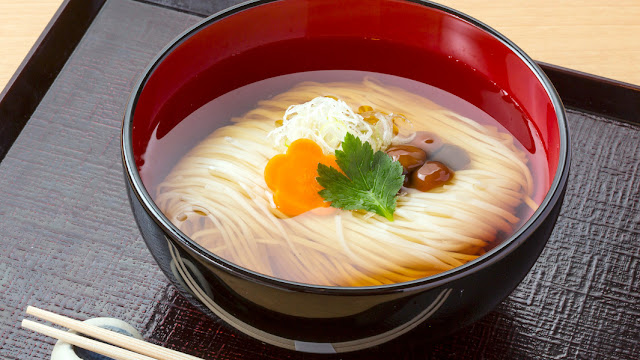Udon, a staple Japanese noodle made from wheat flour, water, and salt, varies in texture and thickness across different regions of Japan. Regional specialties include the firm Sanuki udon from Kagawa Prefecture and the softer, sweet-sauced Ise udon from Mie Prefecture, among others. This versatile noodle, integral to Japanese food culture and history, is commonly served in various styles like in hot broth or with a cold dipping sauce, reflecting the culinary diversity and traditions of each region.
Inaniwa udon, originating from Inaniwa, Akita Prefecture, Japan, is renowned for its labor-intensive creation and distinct features. These thin, almost transparent white noodles are celebrated for their firm yet smooth texture, often served boiled with dipping sauce or in hot broth. With roots in the Edo period, Inaniwa udon is a cherished Akita delicacy, famed for its unique production process and texture, and adored by udon connoisseurs globally.
Mizusawa udon, hailing from Mizusawa City in Iwate Prefecture, Japan, is distinguished by its thick, soft, and chewy texture, made with high-quality water and wheat. These noodles, known for their clear and smooth surface, are typically served boiled in warm broth or sauce, highlighting their tenderness and rich flavor. A culinary icon with a history of several hundred years, Mizusawa udon is a beloved staple in local food culture and a symbol of Iwate Prefecture's rich culinary heritage.
ひもかわうどん(群馬県)
Himokawa udon, originating from Gunma Prefecture, Japan, is distinctive with its broad, flat ribbon shape, setting it apart from conventional udon varieties. Traditionally boiled briefly and rinsed in cold water, it is typically enjoyed with dipping sauce or otsuyu, acclaimed for its unique texture. Deeply embedded in Gunma's culinary heritage, Himokawa udon's rich history spans centuries, making it a celebrated traditional noodle and a symbol of the region's culture, cherished locally and internationally.
Himi udon, from Himi City in Toyama Prefecture, Japan, is celebrated for its unique texture and artisanal production process, using specific flour types and methods that create a firm, transparent noodle. Often boiled and rinsed in cold water, it's typically served with dipping sauce or hot soup, complementing the local cuisine's fresh seafood. Esteemed for its longstanding cultural significance and distinctive qualities, Himi udon holds a special place in both local traditions and the hearts of udon enthusiasts worldwide.
 |
| 味噌煮込みうどん(愛知県) |
Miso Nikomi Udon, a warm and hearty noodle dish from Nagoya City in Aichi Prefecture, Japan, features thick udon noodles simmered in a rich, red miso-based broth. It's typically loaded with ingredients like chicken, tofu, vegetables, and seafood, all melding flavors within the robust soup. Deeply connected to Nagoya's miso culture, this dish, which gained prominence in the 20th century, is celebrated for its comforting warmth and distinctive taste, beloved by both locals and visitors.
 |
| 伊勢うどん(三重県) |
Ise udon, from Ise City in Mie Prefecture, Japan, is famed for its unusually soft, thick noodles and a distinctive black, sweet soy sauce-based tare. Cooked to be much softer than typical udon and simmered in the rich sauce for an extended period, these noodles offer a unique texture and flavor. Deeply tied to the Ise Shrine and its historical traditions, Ise udon has evolved into a symbolic regional dish, cherished for its unique culinary identity by locals and international enthusiasts alike.
Sanuki udon, a specialty of Kagawa Prefecture in Japan, stands out for its firm and smooth texture, achieved through unique production techniques. After boiling, the noodles are rinsed in cold water, enhancing their firmness, and are typically served either dipped in sauce, in warm broth, or directly in hot broth. Emblematic of Kagawa's rich culinary heritage, affectionately dubbed "Udon Prefecture," Sanuki udon is revered both nationally and globally for its artisanal quality and versatile serving styles.
 |
| 五島うどん(長崎県) |
Goto Udon, originating from the Goto Islands in Nagasaki Prefecture, Japan, is characterized by its clear, thin, and firm noodles that reveal a deeper flavor upon chewing. These noodles are typically boiled, cooled in cold water, and then served with either hot broth or a cold dipping sauce, highlighting their simple yet profound taste. A vital part of the Goto Islands' traditional food culture, Goto Udon, with its centuries-old history, is a testament to the local artisans' dedication and a symbol of the region's rich culinary heritage, enjoyed by both residents and visitors.
Udon Noodles offers a captivating exploration of Japan's diverse udon noodle culture, showcasing regional specialties from firm Sanuki to soft, sweet-sauced Ise udon. It beautifully illustrates how these noodles are more than just a dish, but a reflection of the unique history and culture of each region in Japan.





0 件のコメント:
コメントを投稿